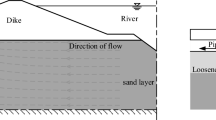Abstract
Backward erosion piping is an important failure mechanism for cohesive water retaining structures which are founded on a sandy aquifer. At present, the prediction models for safety assessment are often based on 2D assumptions. In this work, a 3D numerical approach of the groundwater flow leading to the erosion mechanism of backward erosion piping is presented and discussed. Comparison of the 2D and 3D numerical results explicitly demonstrates the inherent 3D nature of the piping phenomenon. In addition, the influence of the seepage length is investigated and discussed for both piping initiation and piping progression. The results clearly indicate the superiority of the presented 3D numerical model compared to the established 2D approach. Moreover, the 3D numerical results enable a better understanding of the complex physical mechanism involved in backward erosion piping and thus can lead to a significant improvement in the safety assessment of water retaining structures.
Similar content being viewed by others
References
Sellmeijer J B. On the mechanism of piping under impervious structures. Dissertation for the Doctoral Degree. Delft: TU Delft, 1988
Sellmeijer J B, Koenders M A. A mathematical model for piping. Applied Mathematical Modelling, 1991, 15(11–12): 646–651
Sellmeijer H, de la Cruz J L, van Beek VM, Knoeff H. Fine-tuning of the backward erosion piping model through small-scale, mediumscale and IJkdijk experiments. European Journal of Environmental and Civil Engineering, 2011, 15(8): 1139–1154
White C M. The equilibrium of grains on the bed of a stream. Proceedings of the Royal Society of London, 1940, 174(958): 322–338
Van Beek V M, van Meerten H, Nugroho D, Vandenboer K. SBW Piping 5A: Model Development for Initiation of Piping. Deltares, 2012
Miesel D. Rückschreitende Erosion unter bindiger Deckschicht. Berlin, 1978
Van Beek V M, Knoeff H, Sellmeijer H. Observations on the process of backward erosion piping in small-, medium- and full-scale experiments. European Journal of Environmental and Civil Engineering, 2011, 15(8): 1115–1137
Shamy El, Abdelhamid U, Krueger P, An Z. A Particle-based Model of Flow-Induced Scour. In ICSE6. Paris, 2012, 8
Van Beek V M, van Essen H, Vandenboer K. SW Piping 5B: Progression of Piping. Deltares, 2013
Author information
Authors and Affiliations
Corresponding author
Rights and permissions
About this article
Cite this article
Vandenboer, K., van Beek, V. & Bezuijen, A. 3D finite element method (FEM) simulation of groundwater flow during backward erosion piping. Front. Struct. Civ. Eng. 8, 160–166 (2014). https://doi.org/10.1007/s11709-014-0257-7
Received:
Accepted:
Published:
Issue Date:
DOI: https://doi.org/10.1007/s11709-014-0257-7




